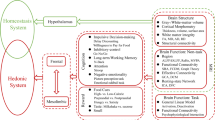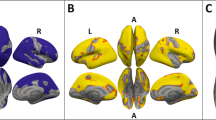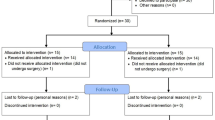Abstract
Background/Objectives:
Obesity-related brain structural abnormalities have been reported extensively, and bariatric surgery (BS) is currently the most effective intervention to produce sustained weight reduction in overtly obese (OB) people. It is unknown whether BS can repair the brain circuitry abnormalities concomitantly with long-term weight loss.
Subjects/Methods:
In order to investigate whether BS promotes neuroplastic structural recovery in morbidly OB patients, we quantified fractional anisotropy (FA), mean diffusivity (MD) and gray (GM) and white (WM) matter densities in 15 morbidly OB patients and in 18 normal weight (NW) individuals. OB patients were studied at baseline and also 1 month after laparoscopic sleeve gastrectomy surgery.
Results:
Two-sample t-test between OB (baseline) and NW groups showed decreased FA values, GM/WM densities and increased MD value in brain regions associated with food intake control (that is, caudate, orbitofrontal cortex, body and genu of corpus callosum) and cognitive-emotion regulation (that is, inferior frontal gyrus, hippocampus, insula, external capsule) (P<0.05, family-wise error correction). Paired t-test in the OB group between before and after surgery showed that BS generated partial neuroplastic structural recovery in the OB group, but the differences had relative less strength and smaller volume (P<0.001).
Conclusions:
This study provides the first anatomical evidence for BS-induced acute neuroplastic recovery that might in part mediate the long-term benefit of BS in weight reduction. It also highlights the importance of this line of gut–brain axis research employing the combined BS and neuroimaging model for identifying longitudinal changes in brain structure that correlated with obesity status.
This is a preview of subscription content, access via your institution
Access options
Subscribe to this journal
Receive 12 print issues and online access
$259.00 per year
only $21.58 per issue
Buy this article
- Purchase on Springer Link
- Instant access to full article PDF
Prices may be subject to local taxes which are calculated during checkout



Similar content being viewed by others
References
Karlsson HK, Tuulari JJ, Hirvonen J, Lepomaki V, Parkkola R, Hiltunen J et al. Obesity is associated with white matter atrophy: a combined diffusion tensor imaging and voxel-based morphometric study. Obesity (Silver Spring) 2013; 21: 2530–2537.
Kurth F, Levitt JG, Phillips OR, Luders E, Woods RP, Mazziotta JC et al. Relationships between gray matter, body mass index, and waist circumference in healthy adults. Hum Brain Mapp 2013; 34: 1737–1746.
Maayan L, Hoogendoorn C, Sweat V, Convit A . Disinhibited eating in obese adolescents is associated with orbitofrontal volume reductions and executive dysfunction. Obesity (Silver Spring) 2011; 19: 1382–1387.
Pannacciulli N, Del PA, Chen K, Le DS, Reiman EM, Tataranni PA . Brain abnormalities in human obesity: a voxel-based morphometric study. Neuroimage 2006; 31: 1419–1425.
Raji CA, Ho AJ, Parikshak NN, Becker JT, Lopez OL, Kuller LH et al. Brain structure and obesity. Hum Brain Mapp 2010; 31: 353–364.
Shott ME, Cornier MA, Mittal VA, Pryor TL, Orr JM, Brown MS et al. Orbitofrontal cortex volume and brain reward response in obesity. Int J Obes (Lond) 2015; 39: 241–21.
Stanek KM, Grieve SM, Brickman AM, Korgaonkar MS, Paul RH, Cohen RA et al. Obesity is associated with reduced white matter integrity in otherwise healthy adults. Obesity (Silver Spring) 2011; 19: 500–504.
Verstynen TD, Weinstein AM, Schneider WW, Jakicic JM, Rofey DL, Erickson KI . Increased body mass index is associated with a global and distributed decrease in white matter microstructural integrity. Psychosom Med 2012; 74: 682–690.
Yokum S, Ng J, Stice E . Relation of regional gray and white matter volumes to current BMI and future increases in BMI: a prospective MRI study. Int J Obes (Lond) 2012; 36: 656–664.
Bruce AS, Holsen LM, Chambers RJ, Martin LE, Brooks WM, Zarcone JR et al. Obese children show hyperactivation to food pictures in brain networks linked to motivation, reward and cognitive control. Int J Obes (Lond) 2010; 34: 1494–1500.
Garcia-Garcia I, Jurado MA, Garolera M, Segura B, Sala-Llonch R, Marques-Iturria I et al. Alterations of the salience network in obesity: a resting-state fMRI study. Hum Brain Mapp 2013; 34: 2786–2797.
Kullmann S, Pape AA, Heni M, Ketterer C, Schick F, Haring HU et al. Functional network connectivity underlying food processing: disturbed salience and visual processing in overweight and obese adults. Cereb Cortex 2013; 23: 1247–1256.
Martin LE, Holsen LM, Chambers RJ, Bruce AS, Brooks WM, Zarcone JR et al. Neural mechanisms associated with food motivation in obese and healthy weight adults. Obesity (Silver Spring) 2010; 18: 254–260.
Rothemund Y, Preuschhof C, Bohner G, Bauknecht HC, Klingebiel R, Flor H et al. Differential activation of the dorsal striatum by high-calorie visual food stimuli in obese individuals. Neuroimage 2007; 37: 410–421.
Stoeckel LE, Weller RE, Cook ER, Twieg DB, Knowlton RC, Cox JE . Widespread reward-system activation in obese women in response to pictures of high-calorie foods. Neuroimage 2008; 41: 636–647.
Rao RS . Bariatric surgery and the central nervous system. Obes Surg 2012; 22: 967–978.
Sjostrom L, Narbro K, Sjostrom CD, Karason K, Larsson B, Wedel H et al. Effects of bariatric surgery on mortality in Swedish obese subjects. N Engl J Med 2007; 357: 741–752.
Vidal P, Ramon JM, Goday A, Benaiges D, Trillo L, Parri A et al. Laparoscopic gastric bypass versus laparoscopic sleeve gastrectomy as a definitive surgical procedure for morbid obesity. Mid-term results. Obes Surg 2013; 23: 292–299.
Steele KE, Prokopowicz GP, Schweitzer MA, Magunsuon TH, Lidor AO, Kuwabawa H et al. Alterations of central dopamine receptors before and after gastric bypass surgery. Obes Surg 2010; 20: 369–374.
van de Sande-Lee S, Pereira FR, Cintra DE, Fernandes PT, Cardoso AR, Garlipp CR et al. Partial reversibility of hypothalamic dysfunction and changes in brain activity after body mass reduction in obese subjects. Diabetes 2011; 60: 1699–1704.
Ochner CN, Kwok Y, Conceicao E, Pantazatos SP, Puma LM, Carnell S et al. Selective reduction in neural responses to high calorie foods following gastric bypass surgery. Ann Surg 2011; 253: 502–507.
Ochner CN, Stice E, Hutchins E, Afifi L, Geliebter A, Hirsch J et al. Relation between changes in neural responsivity and reductions in desire to eat high-calorie foods following gastric bypass surgery. Neuroscience 2012; 209: 128–135.
Frank S, Wilms B, Veit R, Ernst B, Thurnheer M, Kullmann S et al. Altered brain activity in severely obese women may recover after Roux-en Y gastric bypass surgery. Int J Obes (Lond) 2014; 38: 341–348.
HAMILTON M . The assessment of anxiety states by rating. Br J Med Psychol 1959; 32: 50–55.
HAMILTON M . A rating scale for depression. J Neurol Neurosurg Psychiatry 1960; 23: 56–62.
Gearhardt AN, Corbin WR, Brownell KD . Preliminary validation of the Yale Food Addiction Scale. Appetite 2009; 52: 430–436.
Clark SM, Saules KK . Validation of the Yale Food Addiction Scale among a weight-loss surgery population. Eat Behav 2013; 14: 216–219.
Pepino MY, Stein RI, Eagon JC, Klein S . Bariatric surgery-induced weight loss causes remission of food addiction in extreme obesity. Obesity (Silver Spring) 2014; 22: 1792–1798.
Smith SM, Jenkinson M, Johansen-Berg H, Rueckert D, Nichols TE, Mackay CE et al. Tract-based spatial statistics: voxelwise analysis of multi-subject diffusion data. Neuroimage 2006; 31: 1487–1505.
Wakana S, Jiang H, Nagae-Poetscher LM, van Zijl PC, Mori S . Fiber tract-based atlas of human white matter anatomy. Radiology 2004; 230: 77–87.
Ashburner J, Friston KJ . Unified segmentation. Neuroimage 2005; 26: 839–851.
Tzourio-Mazoyer N, Landeau B, Papathanassiou D, Crivello F, Etard O, Delcroix N et al. Automated anatomical labeling of activations in SPM using a macroscopic anatomical parcellation of the MNI MRI single-subject brain. Neuroimage 2002; 15: 273–289.
Fransson P, Marrelec G . The precuneus/posterior cingulate cortex plays a pivotal role in the default mode network: Evidence from a partial correlation network analysis. Neuroimage 2008; 42: 1178–1184.
Bruce AS, Bruce JM, Ness AR, Lepping RJ, Malley S, Hancock L et al. A comparison of functional brain changes associated with surgical versus behavioral weight loss. Obesity 2014; 22: 337–343.
Demos KE, Heatherton TF, Kelley WM . Individual differences in nucleus accumbens activity to food and sexual images predict weight gain and sexual behavior. J Neurosci 2012; 32: 5549–5552.
Stice E, Yokum S, Bohon C, Marti N, Smolen A . Reward circuitry responsivity to food predicts future increases in body mass: moderating effects of DRD2 and DRD4. Neuroimage 2010; 50: 1618–1625.
Smucny J, Cornier MA, Eichman LC, Thomas EA, Bechtell JL, Tregellas JR . Brain structure predicts risk for obesity. Appetite 2012; 59: 859–865.
Volkow ND, Wang GJ, Fowler JS, Telang F . Overlapping neuronal circuits in addiction and obesity: evidence of systems pathology. Philos Trans R Soc Lond B Biol Sci 2008; 363: 3191–3200.
Wang GJ, Volkow ND, Telang F, Jayne M, Ma J, Rao M et al. Exposure to appetitive food stimuli markedly activates the human brain. Neuroimage 2004; 21: 1790–1797.
Walther K, Birdsill AC, Glisky EL, Ryan L . Structural brain differences and cognitive functioning related to body mass index in older females. Hum Brain Mapp 2010; 31: 1052–1064.
Driscoll I, Beydoun MA, An Y, Davatzikos C, Ferrucci L, Zonderman AB et al. Midlife obesity and trajectories of brain volume changes in older adults. Hum Brain Mapp 2012; 33: 2204–2210.
Hassenstab JJ, Sweet LH, Del Parigi A, McCaffery GM, Haley AP, Demos KE et al. Cortical thickness of the cognitive control network in obesity and successful weight loss maintenance: a preliminary MRI study. Psychiatry Res 2012; 202: 77–79.
Bruce JM, Hancock L, Bruce A, Lepping RJ, Martin L, Lundgren JD et al. Changes in brain activation to food pictures after adjustable gastric banding. Surg Obes Relat Dis 2012; 8: 602–608.
Ojemann GA, Schoenfield-McNeill J, Corina DP . Anatomic subdivisions in human temporal cortical neuronal activity related to recent verbal memory. Nat Neurosci 2002; 5: 64–71.
Whitney C, Kirk M, O'Sullivan J, Lambon RM, Jefferies E . The neural organization of semantic control: TMS evidence for a distributed network in left inferior frontal and posterior middle temporal gyrus. Cereb Cortex 2011; 21: 1066–1075.
Tang DW, Fellows LK, Small DM, Dagher A . Food and drug cues activate similar brain regions: a meta-analysis of functional MRI studies. Physiol Behav 2012; 106: 317–324.
Acknowledgements
This work is supported by the National Natural Science Foundation of China under Grant Nos. 81271549, 81470816, 61131003, 61431013, 81201081, 81227901, 81120108005, 81501543, 81371530, 81571751 and 81571753; the Shaanxi Provincial Natural Science Foundation under Grant No. 2015JM3117; and the Project for the National Key Basic Research and Development Program (973) under Grant No. 2011CB707700. We thank Dr Samantha Cunningham of NIAAA and Dr Jiayu Liu of Yale University for proofreading.
Author information
Authors and Affiliations
Corresponding authors
Ethics declarations
Competing interests
The authors declare no conflict of interest.
Additional information
Supplementary Information accompanies this paper on International Journal of Obesity website
Rights and permissions
About this article
Cite this article
Zhang, Y., Ji, G., Xu, M. et al. Recovery of brain structural abnormalities in morbidly obese patients after bariatric surgery. Int J Obes 40, 1558–1565 (2016). https://doi.org/10.1038/ijo.2016.98
Received:
Revised:
Accepted:
Published:
Issue Date:
DOI: https://doi.org/10.1038/ijo.2016.98
This article is cited by
-
Diffusion tensor imaging findings in the hunger and satiety centers of the brain after bariatric surgery: a preliminary study
Irish Journal of Medical Science (1971 -) (2023)
-
Electroacupuncture enhances resting-state functional connectivity between dorsal caudate and precuneus and decreases associated leptin levels in overweight/obese subjects
Brain Imaging and Behavior (2022)
-
Alterations in Functional and Structural Connectivity of Basal Ganglia Network in Patients with Obesity
Brain Topography (2022)
-
Long-term changes in insula-mesolimbic structural and functional connectivity in obese patients after laparoscopic sleeve gastrectomy
Clinical Autonomic Research (2022)
-
Laparoscopic sleeve gastrectomy improves brain connectivity in obese patients
Journal of Neurology (2020)



